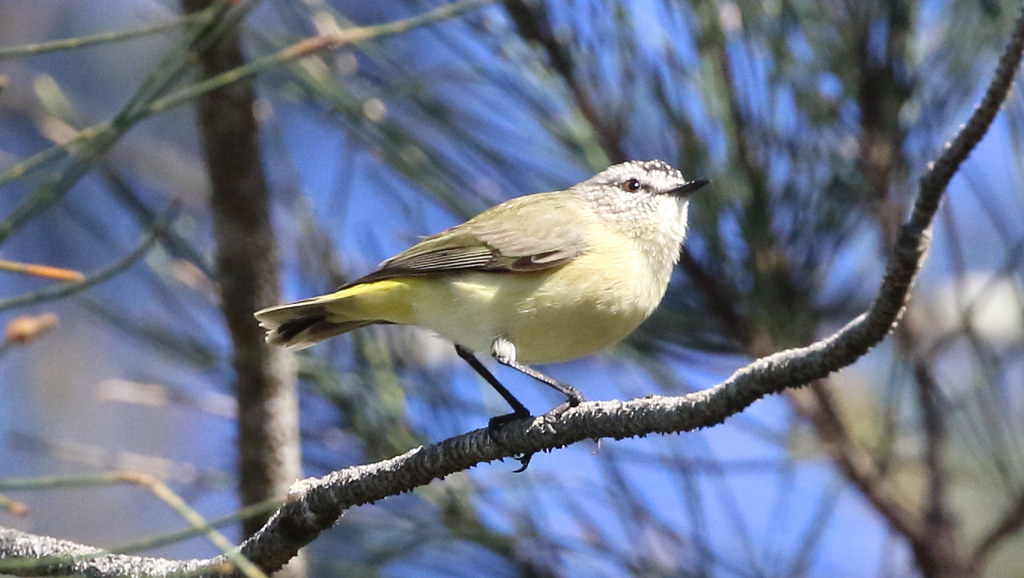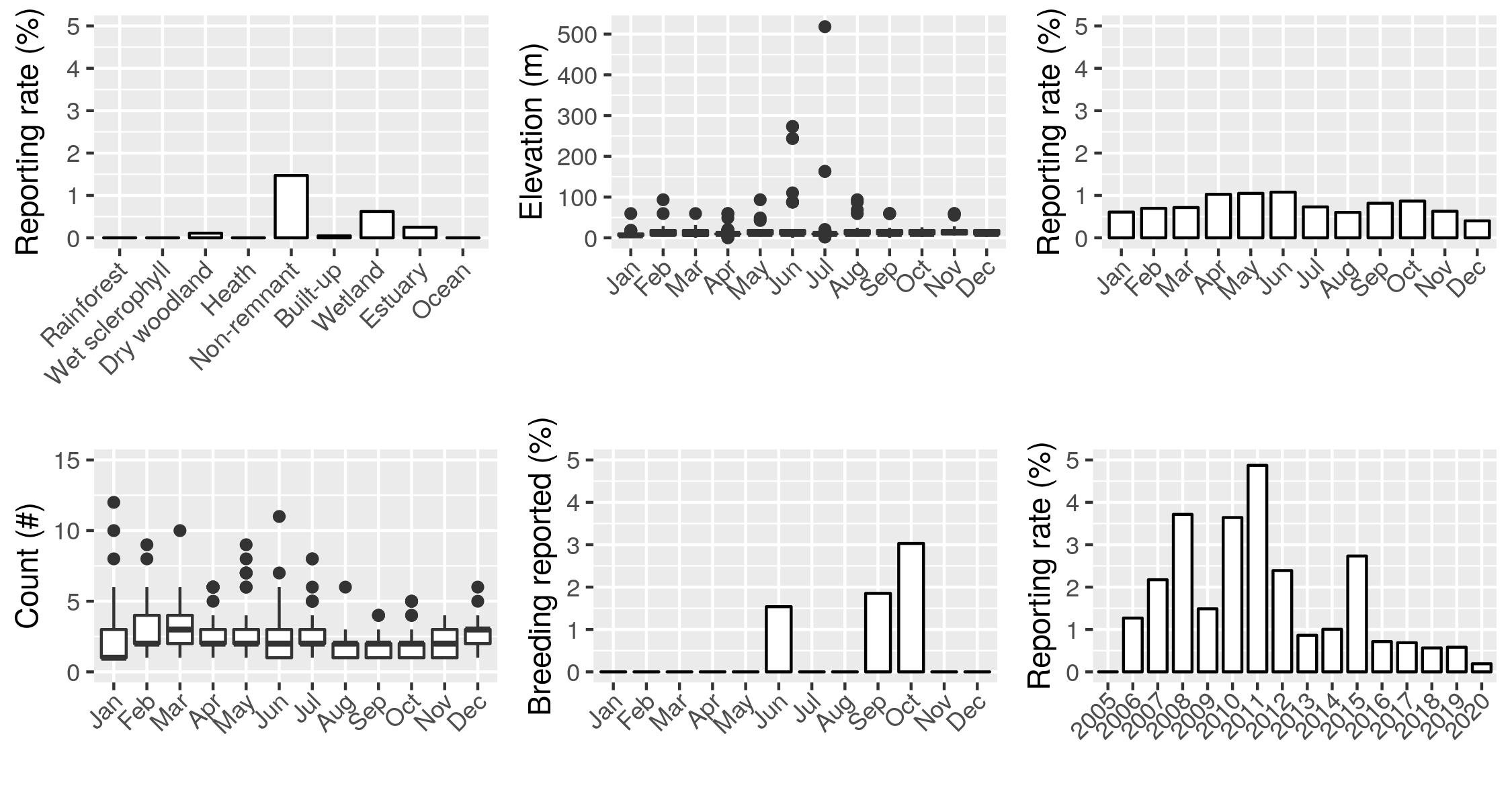Yellow-rumped Thornbill Acanthiza chrysorrhoa
Category A; Uncommon widespread resident.

Patchy distribution within the Brisbane region, with only a handful of regular sites but many more locations where the species has occurred, often only as one-off records. While probably not of major conservation concern in Brisbane, it is worth monitoring for signs of population decline or reduction in distribution. Photo by Richard Fuller, Priors Pocket, 17 Jun 2018
| Threat status | Brisbane status |
|---|---|
| IUCN Least Concern | eBird records 593 |
| National Not listed | Atlas squares 52 |
| Queensland Not listed | Reporting rate 1% |
Marc Anderson - Bowra Station, Queensland, Australia Marc Anderson - Flinders Ranges, South Australia, Australia
The Yellow-rumped Thornbill is a distinctive small passerine with a bright yellow rump and conspicuous facial markings (Menkhorst et al. 2017). It is the largest species of thornbill, up to 12cm in length (Higgins & Peter 2002) and diverged early from other thornbills (Marki et al. 2017), consequently it is quite distinct within the genus. If seen well it can be identified easily, and its distinctive tinkling calls further differentiate it from other thornbills. Birds are patchily distributed in Brisbane and are only common at a few sites, but wander widely.

A species of open habitats, the Yellow-rumped Thornbill occurs patchily across Brisbane, but beyond our border is common across much of Western Australia, South Australia, southern Northern Territory and the south east States. Yellow-rumped Thornbill has been recorded from most districts across mainland Brisbane excluding the wetter forests of the Camel’s Head and the south east corner (and the species has never been recorded on Moreton Island), but it is never really common and typically occurs in small numbers. Strongholds are at Prior’s Pocket, Oxley Creek Common and the open country near the mouth of the Brisbane River. The highest count is of 12 birds at Oxley Creek Common (Possingham 2009) but typical counts are much lower, with only a handful of records over 5 birds.
The species is present in Brisbane year-round, although there is a substantial increase in reporting rate over the winter months, suggesting that birds might move into the city during winter, or our local birds might wander more widely at that time of year. The biggest counts also tend to occur in winter, suggesting immigration is a possibility, but in the absence of banding data it is difficult to be sure. There is no clear trend in abundance over the past decade, although there have been rather few records in the last 4-5 years, and the species’ abundance fluctuates from year to year.
Distribution and Habitat
The Yellow-rumped Thornbill is distributed widely across Brisbane, with a distinct preference for low altitude open habitats, although the species has been recorded up to 300m. Most commonly found in non-remnant and wetland edge habitats, the Yellow-rumped Thornbill favours open country with some tree cover, and birds can be seen on the ground, on fences, or in trees. Open habitats that seem suitable for the species occur fairly widely within Brisbane, and given the abundance of the species across much of Australia, it is perhaps surprising that Yellow-rumped Thornbill is as uncommon as it is within Brisbane. Even at its seasonal peak in June, the species is only observed on about 2.5% of checklists.
Seasonality and Breeding
The species is present in Brisbane all year, although there is a clear increase in reporting rate over the cooler months. Breeding records are currently too sparse to form a pattern, but so far breeding has been reported in June, September and October. It would be good to collect more breeding data on this species, and to find out more about its seasonal movements and any evidence of migration or nomadism.
Trends
The reporting rate of Yellow-rumped Thornbill has been rather variable from year to year, with bumper years in 2008 and 2011 (reported on ~5% of checklists), but much rarer in other years such as 2014, 2016 and 2017 (reported on about 1% of checklists during these years). It would be good to conduct some analysis to understand why these fluctuations are happening, but no clear directional trend is apparent from the data, suggesting we aren’t yet witnessing a wholesale decline. Outside Brisbane, the species is common across large parts of the continent, and as such is of no particular conservation concern nationally. Yet its apparent scarcity in Brisbane means it is a species that should be monitored fairly closely.
Information Gaps
- Identify the reasons behind its fluctuating abundance across years
- Determine whether nomadic or migratory movements are occurring
- Collect more breeding data so the seasonal pattern of breeding can be established
- Collect audio and photographic records
Key Conservation Needs
- Monitor abundance so any declines can be detected early
- Be vigilant for habitat loss in any of its Brisbane strongholds
Contributors to Species Account
- Louis Backstrom
- Richard Fuller
References
Menkhorst P, Rogers DI & Clarke R (2017) The Australian Bird Guide. CSIRO Publishing.
Higgins PJ & Peter JM (2002) Handbook of Australian, New Zealand & Antarctic birds. Oxford University Press.
Marki PZ, Jønsson KA, Irestedt M, Nguyen JM, Rahbek C & Fjeldså J (2017) Supermatrix phylogeny and biogeography of the australasian meliphagides radiation (aves: Passeriformes). Molecular phylogenetics and evolution, 107, 516–529.
Possingham H (2009) eBird Checklist: http://ebird.org/view/checklist/S17747770.